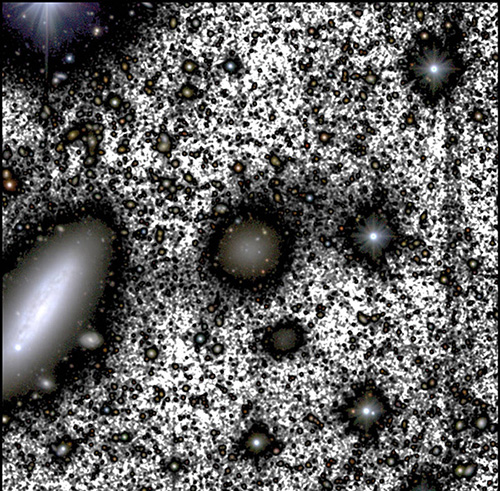Observations from the Hubble Space Telescope have solved a significant cosmic mystery that will help scientists better understand dark matter, an enigmatic substance theorized to outnumber normal matter at least fivefold. In 2018, astronomers were surprised to find a galaxy, designated NGC 1052-DF2, that seemingly lacked dark matter. New scans of this galaxy have provided a reason for the lack of dark matter: tidal disruptions. These are disruptions to a galaxy's matter and dark-matter content that are caused by gravitational interactions with neighboring galaxies. Tidal disruptions now appear able to thoroughly strip dark matter from a galaxy. Additional study of these disruptions could help in further specifying dark matter’s properties, potentially contributing to the eventual direct identification of this theoretical substance. See also: Dark matter; Galaxy; Hubble Space Telescope

As its name implies, dark matter does not emit any observable light. Dark matter does, however, interact quite noticeably with other matter via the force of gravity. In this way, predominant dark matter serves as a sort of cosmic scaffold upon which the "normal," visible matter comprising galaxies is hung. Researchers can indirectly estimate the amount of dark matter in a galaxy by measuring a galaxy's total mass. A total mass estimate derives from tracking the speed of individual stars as well as dense collections of stars known as globular clusters throughout the galaxy. These motions are, in turn, determined by gravity exerted by all the available mass in a galaxy. Just such a measurement of very slowly moving stars and clusters led to the initial discovery of NGC 1052-DF2's confounding lack of dark matter. See also: Globular clusters; Gravity; Light; Mass; Star; Star clusters
More detailed measurements of the arrangement of stars and globular clusters in NGC 1052-DF2 have now lent support to the tidal disruption theory. Two ground-based telescopes—the Gran Telescopio Canarias (GTC) telescope and the IAC80 telescope, both in Spain's Canary Islands—aided in tracking the celestial objects' movements and distributions. The data are consistent with the gravity of at least one massive, nearby galaxy—designated NGC 1035—pulling stars and star clusters right out of NGC 1052-DF2. The dark matter apparently was removed first, with this initial removal leaving the remaining visible matter likely more susceptible to major tidal disruption. Eventually, NGC 1052-DF2 is likely to be fully torn apart by NGC 1035 and other galaxies in its vicinity. The sundered galaxy's contents will be scattered throughout surrounding space, although some stars will ultimately be subsumed by the disrupting galaxies. See also: Astronomical observatory





